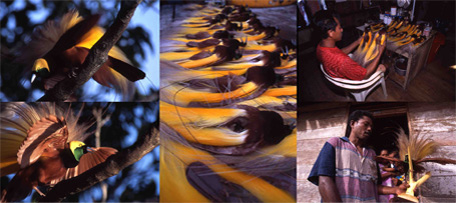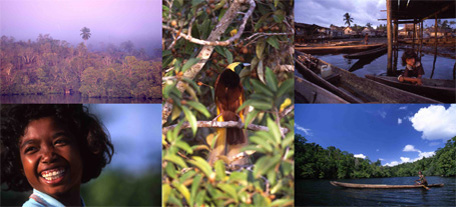Bird of paradise
Lost in the fringes of Indonesia, the small Aru archipelago has fascinated merchants and natural scientists since the last centuries. The forest land and waters that make up this archipelago have always provided an abundance of marvels and natural resources, attracting both those in the quest for profits as well as those who have come to study nature. In the forest of the Aru Islands there dwells a flamboyant wonder known as the Greater bird of paradise, one of the most beautiful birds known in the world.
Wok-wak-wak-wak : The call of the bird of paradise
In the Aru Islands, right at the southeast of the Moluccas in Indonesia, while the wind blows from the East, the forest echoes since dawn with the strident and intriguing wok-wak-wak-wak. These are the male Greater birds of paradise (Paradisaea apoda), announcing their arrival to the females. They gather in the trees’ canopies and begin their fabulous dances. Year after year, the same males choose the same branch of the same tree to practice their rituals. These genuine contests have only one goal: To seduce as many females as possible by making a display of all the beauty their plumes bestow. After carefully clearing the branch on which they perform their dances, the birds rehearse for the next five months their daily dance, where colours and postures rival in splendour. Sir Alfred Russell Wallace, the renowned British naturalist, during his visit to the Malay Archipelago, was himself fascinated by the displays and the beauty of these extremely bashful birds.
Plumes for hats
The population of the Greater birds of paradise drastically diminished when they were hunted down for their plumes, a great asset for Europeans at the end of the 19th century. Today, in the Papuan forests, people still ornate themselves with such plumes. Since 1900, tens of thousands of specimens have been sold in Europe, where bids have attained unimaginable sums. The decline of the population of birds of paradise was further accelerated since the appearance of modern weapons. Traditionally, hunters would have to climb thirty metres up trees and wait patiently, bow and arrow in hand, hidden in leaf-made hideouts, built according to ancient rituals. Today, they only have to point their guns at the birds displaying from the ground. Whilst a villager can be paid about 10$, a stuffed specimen can be resold for 20 to 30 times that price in Jakarta, and much more in China, Korea, or in Japan, whose boatmen comb the Indonesian seas. However, most of the birds shot down are sold to the local military corps and public servants, who in turn offer these to their superiors, waiting to take their places...
Conservation
At Kejilaki Mar, however, on Wokam Island, in the centre of the Aru forest, the men of the influential Mangar clan have decided not to kill their birds of paradise, so that their reputation may not be marred. Understanding that the vanen—local name for the Greater bird of paradise—are a wealth worth cherishing rather than hunting, now they regularly spend time at the foot of the trees during display season (June to October), to thwart anyone’s intention to steal these birds. Every year a new adult male arrives to mingle with the older ones, making Kejilaki Mar one of the rarest places exceptionally populated by the Greater birds of paradise in the whole of the Aru Archipelago. However, as greed pervades, and the forests are vast, it is practically impossible to avoid the profitable intentions of poachers.
The difficulty to photograph
To listen or observe the Greater bird of paradise is not in itself a great difficulty. One can watch their performances from the ground, visualize their dances, and tell stories about them. The only impediment is to reach the Aru Islands. It is only after a long journey, a very long journey when one can walk on that ground, on the ground of paradise. To photograph or film the birds’ display is another challenge in which not many succeed. Firstly, one has to be able to climb 30 to 40 metres up trees, know how to build a traditional hideout, and, above all, learn to be patient. Just then, some images may be caught.
Photography vs video
During my visits to Indonesia, going to the Aru Archipelago became fixed in my mind. I was longing to photograph the Greater bird of paradise which had become the reason for my long nights of waking dreams. When for the first time I had the chance to hear a Greater bird of paradise, I also heard the dry noise of a rifle, and a heavy fall echoing in the forest. My first Greater bird of paradise was presented to me with smiles, pride expressed on two faces. “But it’s a vanen!” I cried. Two mouths murmured a victorious “yes”. After that day of January 2001, I knew for sure that something bound me to that bird. To photograph the displays of the Greater bird of paradise became an obsession. And immediately after this, another thought came to me: Film the displays of the Greater birds of paradise and try to reveal all the stories they have to tell. The photographic image was beautiful, although lacking one component: Movement, the movement of a repeated choreography.
With this belief within me from then on, I immediately thought of my alter ego, Miguel Garcia: Only he would be able to render with his camera the birds’ poetry and their surroundings. The only thing to do was to pack our backpacks…
News
"mutiara, legend of a pearl" now in DVD!
Don't wait to order it...
Film 52min, Bonus 15min, 3 languages (FR, ENG&NL subtitles).
Only 29.- (shipping incl., for Switzerland only, other countries contact us)
All you ever wanted to know about VilbrekPrOd third movie!
"Vanen, Plumes from Paradise", Best pedagogical documentary award, Festival du film ornithologique de Ménigoute (Press release (in French))
Vanen on DVD it'sFilm 52min, Bonus 20min, 4 languages (FR, ENG, NL, DE (untertitelt)),
is still sold!



